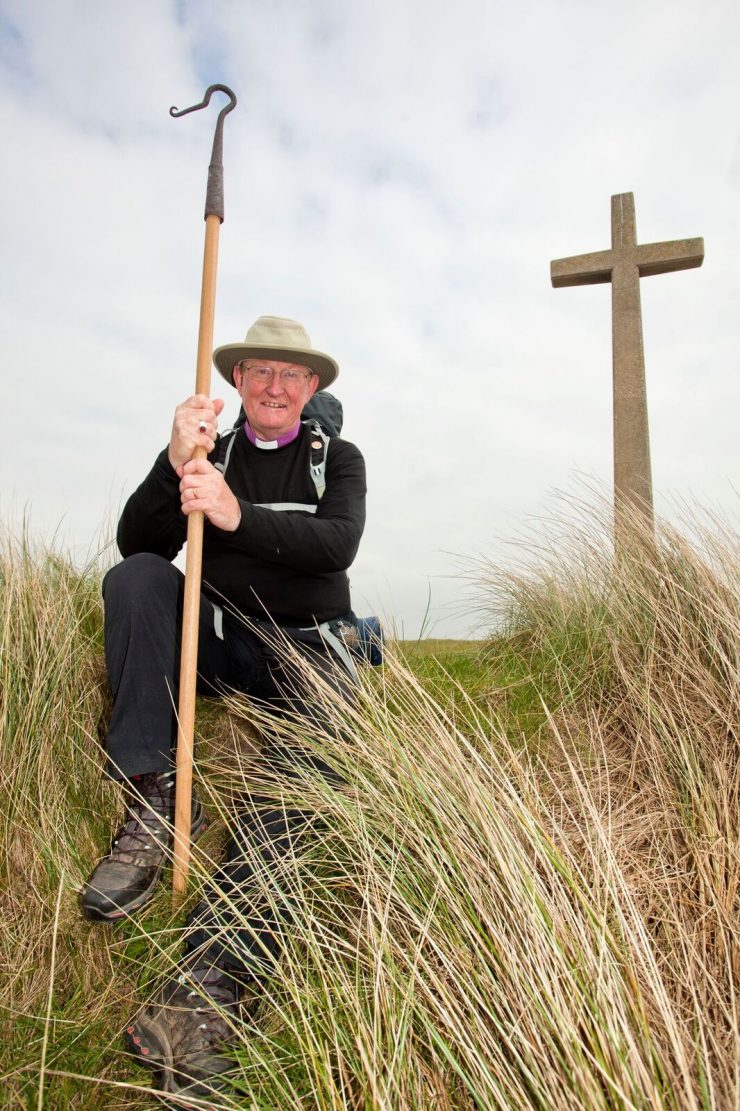Pilgrimages are in the zeitgeist – it’s official
The Right Revd Chris Goldsmith, Bishop of St Germans is, at the moment of writing, not just completing the Cornish Celtic Way designed by Revd Nigel Marns, but is helping to embed a rich spiritual seam that is running the length of Cornwall. From St Germans – the seat of the first Cornish Bishop – to St Michael’s Mount in Marazion, The Cornish Celtic Way has all the promise of a spiritual revival in our county.
“We have to do things differently if the church is to survive,” says Revd Nigel. “Pilgrimages are not just about people taking journeys to find themselves, they can be about the church finding people.” He explained that people take pilgrimages for many reasons, of which only one could include spirituality. It could just be an opportunity to escape the everyday to take time for a re-boot, or to walk in the countryside, connect with nature or find out about local history.
Whatever the reason, when walking along the Cornish Celtic Way, it would be hard to avoid a church, a holy place, standing stone or the footsteps of saints. These are routes and places that have been steeped in prayer for centuries, blessed over hundreds of years, and today offer a blessing to pilgrims, walkers or tourists, accidental or otherwise.
 Churches can be part of that by making themselves open, available and welcoming. It might be one in only a handful of times that someone has had cause to walk into a church. “It’s about the church meeting people where they are and finding ways to bless and surprise them,” says Revd Nigel.
Churches can be part of that by making themselves open, available and welcoming. It might be one in only a handful of times that someone has had cause to walk into a church. “It’s about the church meeting people where they are and finding ways to bless and surprise them,” says Revd Nigel.
Revd Canon Vanda Perret, Rector of the Land’s End Benefice, provides a wonderful example of how this can be done within St Levan, a beautiful church on the Land’s End to John O’Groats route. Inside, walkers will find an altar designated to them and, as well as a blessing, they can be refreshed with bottled water, snacks-to-go and a backpack’s worth of encouragement.
Having had the vision for a pilgrimage laid on his heart, Revd Nigel took a sabbatical last year and undertook the very practical task of seeing whether it was possible. When he set out, he thought he would use the route as a basis for a theological-type book that he would write. He soon realised that God had other ideas and is instead putting together a more practical, accessible book that could be picked up by walkers, adventurers, the spiritually hungry or the curious.
There were so many practical considerations to consider. “I started taking notes of where the loos were, where to buy food, how much a bus cost to take you to or from the route as well as which Saints had walked, ministered or even died there. Then there are things like how steep a path is, is it accessible? Has it been blocked or diverted?” said Revd Marns. “I was very keen for it not to be a church crawl, but most definitely a route that took people to holy places. I began touching all the standing stones – they had been placed hundreds of years ago and marked places of prayer, healing or just a gathering of people. I felt energised by what went before, but also what was being laid down now. A renewal of prayer andblessing for the land and the people walking on it.”
And so the book, that Revd Nigel is now in the final stages of editing, will include practical advice as well as a Psalm, Gospel or even Van Morrison lyrics, whatever seems appropriate for the place. There will be historical snippets, information on the Saint or local folklore. Revd Nigel has not been shy of enlisting his congregation for research. On occasion, he has swapped the traditional Sunday morning service for a stride out across an ancient path. “It’s a great way to get people talking, by walking side-by-side,” he says. He explained that in these days when there is so much pulling apart and fear of ‘other’ it is wonderful to have the chance for people to talk in non-confrontational ways. And to do church differently, walking, engaging in nature, the physicality of using our bodies, can be so powerful, he says. When asked about the older church-members who might not be able to take part, Revd Nigel pointed out that their needs are met on almost every other Sunday, so breaking out of the routine once in a while really wasn’t a problem.
Revd Nigel’s ultimate vision is to make St Michael’s Mount a pilgrim destination, a holy place that people want to journey too. He’d also like to enshrine two weeks every year, maybe even twice a year, when the Cornish Celtic Way is a designated pilgrimage. “I’d like people to be able to join the route, stay more cheaply, maybe sleep in church halls for a donation, or be offered a bed and a meal by parishioners. The churches should all be open, accessible and offering respite, a spiritual sanctuary as well as shelter from the rain – this is Cornwall after all – and a chance to connect and draw from the blessings of the Saints entrenched in the route down the centuries.
To find out more, and see how the book’s progressing, go to Revd Nigel Marns’ website, www.cornishcelticway.com






